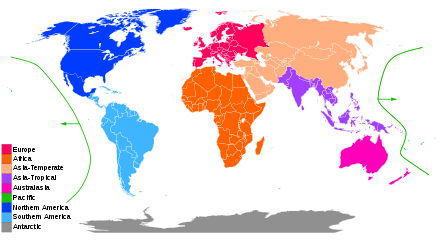Level 1: botanical continents

The WGSRPD defines nine botanical continents (Level 1), each assigned a single digit code from 1 (Europe) to 9 (Antarctica). Although it is said that "popular concepts of the continents of the world have been maintained, but with one or two slight modifications", [3] some of the botanical continents are notably different from the traditional geographical continents. In particular, Asia is divided into two botanical continents; 5 Australasia consists only of Australia and New Zealand and small outlying islands; most of the islands in the Pacific Ocean are allocated to 6 Pacific; and the division of the Americas into 7 Northern America and 8 Southern America differs from the traditional North America and South America. [3]
1 Europe
The botanical continent of Europe is defined broadly in line with Flora Europaea [5] and with the traditional geographical definition. To the north-west it includes Iceland and Svalbard (Spitsbergen). The southern boundary with Africa encloses most of the Mediterranean islands. The eastern boundary places Crimea and European Russia in Europe, with the border defined by the administrative units. Novaya Zemlya is excluded from Europe. The south-eastern boundary excludes the Caucasus and Turkey east of the Bosporus, as well as the Eastern Aegean Islands and Cyprus, which although geopolitically part of Europe are considered floristically part of Western Asia. [11]
2 Africa
The botanical continent of Africa corresponds closely to the usual geographical definition. It excludes the Sinai Peninsula, politically a part of Egypt, which is placed in region 34 Western Asia. To the west, it includes islands grouped as Macaronesia, comprising the Azores, Madeira, the Canary Islands, the Savage Islands and the Cape Verde islands. To the east, it includes Madagascar and other Indian Ocean islands out as far as the island of Rodrigues. [12]
3 Asia-Temperate
The geographical continent of Asia is divided into two botanical continents, 3 Asia-Temperate and 4 Asia-Tropical. The reason for the division was described as largely for convenience. [3] Asia-Temperate borders Europe and Africa; the boundaries are described above. To the south-east, the Indian Subcontinent and the rest of Asia from region 41 Indo-China southwards are placed in Asia-Tropical. [13]
4 Asia-Tropical
Asia-Tropical forms the second part of the traditional geographical continent of Asia. Its western and northern boundaries are formed by the two regions 40 Indian Subcontinent and 41 Indo-China. The southern boundary separates Asia-Tropical from Australia. The south-eastern boundary was changed between the first edition of 1992 and the second edition of 2001. In the first edition, Asia-Tropical was divided into three regions: 40 Indian Subcontinent, 41 Indo-China and 42 Malesia. The eastern boundary of Malesia was placed between the Bismarck Archipelago and the Solomon Islands Archipelago, which were put into region 60 Southwest Pacific. It was subsequently argued that it made more "floristic sense" to link the Solomon Islands with the Bismarck Archipelago and the island of New Guinea. Accordingly, in the second edition, a new region 43 Papuasia was created within Asia-Tropical, comprising New Guinea, Near Oceania (the Bismarck Archipelago and the Solomon Islands Archipelago), so that Asia-Tropical consists of four regions. [14]
5 Australasia
The botanical continent of Australasia, as defined by the WGSRPD, consists only of Australia and New Zealand, plus outlying islands. The name was described as having been "controversial", since it has been used to describe larger areas. [15] Other definitions may include Indonesia, New Guinea and many Pacific islands, which the WGSRPD divides between 4 Asia-Tropical and 6 Pacific.
6 Pacific
The WGSRPD groups most islands with a nearby continental landmass, usually the closest but may also make a decision influenced by the floristic similarity (hence the placement of the Azores with Africa and not Europe). The exception is the islands of the central part of the Pacific Ocean, which are placed in a separate botanical continent. The largest of these islands include New Caledonia, Fiji and Hawaii. [16]
7 Northern America
The WGSRPD divides the Americas into 7 Northern America and 8 Southern America rather than into the traditional continents of North America and South America. The boundary between Northern America and Southern America was changed from the first edition to the second edition. In the first edition, a south-eastern part of Mexico was included in Southern America, the rest of Mexico being placed in Northern America. This followed the boundary of Mesoamerica in Flora Mesoamericana. However, it proved unpopular, especially with Mexican botanists, so in the second edition, all of Mexico is placed in Northern America, which thus consists of Mexico, the contiguous United States plus Alaska, Canada, and Greenland, together with associated offshore islands. [17]
8 Southern America
As noted above, the Americas are divided into 7 Northern America and 8 Southern America rather than into the traditional continents of North America and South America, with the precise boundary between the two having changed between the first and second editions of the WGSRPD. Southern America consists of the Caribbean, the WGSRPD definition of Central America (those countries south of Mexico and north of Colombia), and the traditional geographical continent of South America, together with some offshore islands, such as the Galapagos. [18]
9 Antarctic
The Antarctic botanical continent consists of continental Antarctica, plus a number of Subantarctic Islands, including the Falkland Islands, South Georgia and Tristan da Cunha. [19]